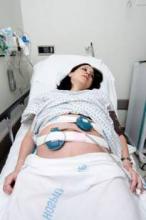Hospital quality measures aimed at decreasing elective early deliveries and cesarean deliveries in low-risk women were not linked with declines in serious maternal or neonatal complications, according to a study published Oct. 15 in JAMA.
Data on more than 100,000 babies born at term in 2010 in New York City hospitals showed that there was wide variation in both maternal and neonatal complications between hospitals, but there was no association between the morbidity rates and the quality metrics studied (JAMA. 2014; 312:1531-41).
Dr. Elizabeth A. Howell of the Icahn School of Medicine at Mount Sinai in New York, and her colleagues, looked at two Joint Commission perinatal quality measures: elective deliveries performed prior to 39 weeks of gestation and cesarean deliveries performed in low-risk nulliparous women.
The rates for elective deliveries before 39 weeks ranged from 15.5 to 41.9 per 100 deliveries among the 41 hospitals studied. For cesarean deliveries in low-risk women, the rates range from 11.7 to 39.3 per 100 deliveries.
There was also a wide range in maternal and neonatal morbidity. Maternal morbidity rates ranged from 0.9 to 5.7 mothers with complications per 100 deliveries, while neonatal morbidity ranged from 3.1 to 21.3 infants with complications per 100 births. Neither of the Joint Commission quality measures was associated with severe complications.
Dr. Howell and her colleagues concluded that while overutilization measures may be important, they aren’t comprehensive enough to reflect the actual quality of care.
These perinatal measures are not the only hospital-level quality measures not linked to decreases in the outcomes they are designed to influence, the investigators noted. They cited examples where quality measures for heart failure, pneumonia, acute MI, and infection control were not associated with improved outcomes or predicted only small improvements.
Quality measures often “capture only a narrow slice of hospital quality,” Dr. Howell wrote. “There is a need to reassess how these measures are designed and implemented and to think more broadly about constructing meaningful quality measures tightly linked with patient outcomes.”
The researchers called for the development of other quality measures such as metrics aimed at identifying whether hemorrhage and preeclampsia protocols are being used in the delivery suite.
The study was funded by a grant from the National Institute of Child Health and Human Development and a fellowship grant from the European Commission. The researchers reported having no financial disclosures.
mschneider@frontlinemedcom.com
On Twitter @maryellenny


